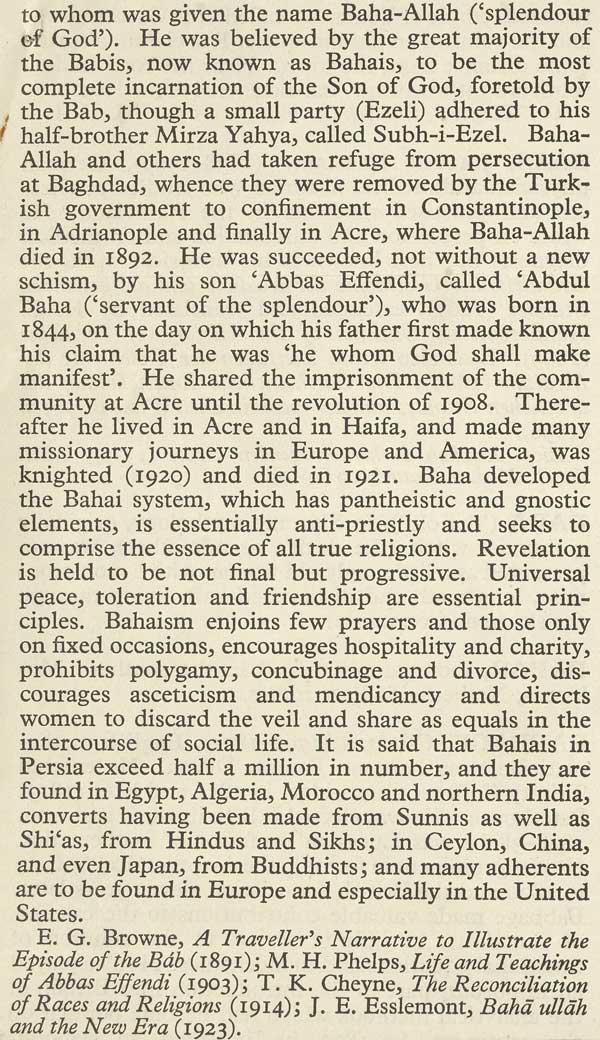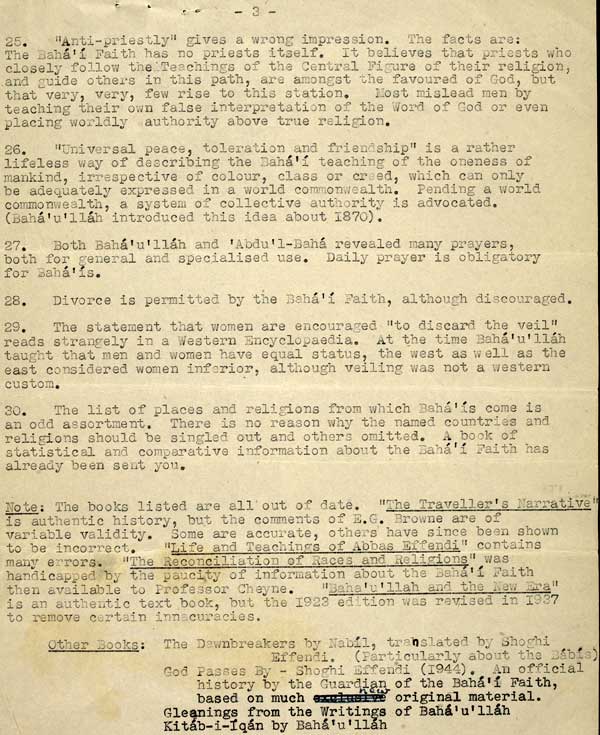1. Text
BABI, a modern Persian sect, derived from the title
Bab-ad-Din ('gate of the faith'), assumed by its
founder, Mirza Ali Mohammed, who was born at
Shiraz in 1821, and in 1844, after a pilgrimage to
Mecca, undertook to form a new religion from a
mixture of Mohammedan, Christian, Jewish and
Parsee elements. His controversies with the mollas
shortly led to his confinement in various towns, where
he formulated his doctrines, privately instructed his
disciples and increased his claims. He sent out missionaries
in various directions, the most famous of
whom was a woman, Qurret al Ain, remarkable for
beauty and intelligence and skilled in poetry, who
preached against polygamy. The sect soon became
numerous, and was not molested by the reigning
shah; but on the accession of Nasir ad-Din in 1848,
apprehending persecution, they took up arms. Several
Persian armies were routed, but finally the insurgents
were reduced by famine and most of them executed
(1849-50). The Bab had held aloof from the revolt,
but he was arrested and put to death in 1850 after
imprisonment. An attempt by three believers to
assassinate the shah in 1852 led to a terrible persecution
of the sect, when Qurret al Ain was put to death
with many others. The Bab's successor was found
in a Tehrani, Mirza Hosain Ali, born in Nur in 1817,
to whom was given the name Baha-Allah ('splendour
of God'). He was believed by the great majority of
the Babis, now known as Bahais, to be the most
complete incarnation of the Son of God, foretold by
the Bab, though a small party (Ezeli) adhered to his
half-brother Mirza Yahya, called Subh-i-Ezel. Baha-Allah
and others had taken refuge from persecution
at Baghdad, whence they were removed by the Turkish
government to confinement in Constantinople,
in Adrianople and finally in Acre, where Baha-Allah
died in 1892. He was succeeded, not without a new
schism, by his son 'Abbas Effendi, called 'Abdul
Baha ('servant of the splendour'), who was born in
1844, on the day on which his father first made known
his claim that he was 'he whom God shall make
manifest'. He shared the imprisonment of the community
at Acre until the revolution of 1908. Thereafter
he lived in Acre and in Haifa, and made many
missionary journeys in Europe and America, was
knighted (1920) and died in 1921. Baha developed
the Bahai system, which has pantheistic and gnostic
elements, is essentially anti-priestly and seeks to
comprise the essence of all true religions. Revelation
is held to be not final but progressive. Universal
peace, toleration and friendship are essential principles.
Bahaism enjoins few prayers and those only
on fixed occasions, encourages hospitality and charity,
prohibits polygamy, concubinage and divorce, discourages
asceticism and mendicancy and directs
women to discard the veil and share as equals in the
intercourse of social life. It is said that Bahais in
Persia exceed half a million in number, and they are
found in Egypt, Algeria, Morocco and northern India,
converts having been made from Sunnis as well as
Shi'as, from Hindus and Sikhs; in Ceylon, China,
and even Japan, from Buddhists; and many adherents
are to be found in Europe and especially in the United
States.
E. G. Browne, A Traveller's Narrative to Illustrate the
Episode of the Bab (1891); M. H. Phelps, Life and Teachings
of Abbas Effendi (1903); T. K. Cheyne, The Reconciliation
of Races and Religions (1914); J. E. Esslemont, Baha’u’llah
and the New Era (1923).
2. Image scans (click image for larger version)





|
